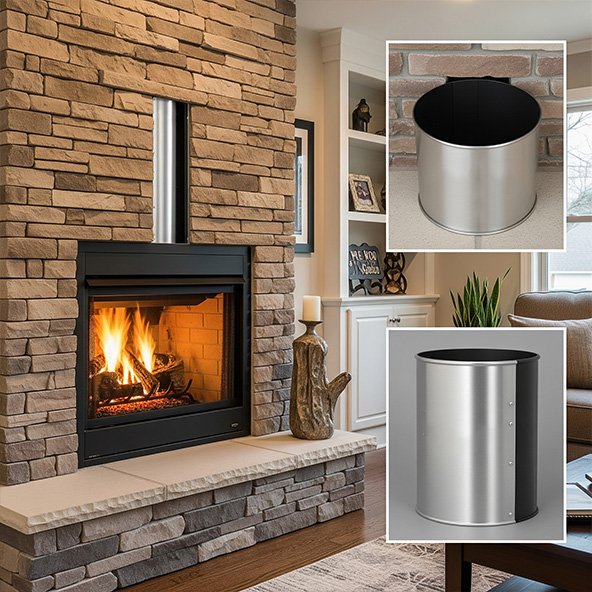There’s something comforting about the glow of a wood-burning fireplace on a cold evening. But behind every warm and cozy fire is a hard-working system that ensures that heat, smoke, and gases are safely directed out of your home. At the core of this system lies the chimney liner — a silent guardian of your chimney’s structural integrity and overall safety.
Many homeowners don’t realize how critical a proper chimney lining system is until they face costly repairs or experience poor fireplace performance. In masonry chimneys, the liner plays a crucial role in managing heat transfer, preventing dangerous carbon monoxide leaks, and reducing the risk of a chimney fire.
If you live in an older home or suspect that your flue may be damaged or outdated, cast in place chimney lining may be the answer to protecting your investment and restoring peace of mind.
What Makes Cast in Place Chimney Liners So Effective?
A cast in place chimney liner is more than just an upgrade — it’s a full rejuvenation of your chimney’s internal structure. These liners are created by pouring a lightweight, highly insulated material around a form inserted into your chimney. As the material cures, it forms a smooth, seamless surface that adheres to the flue walls and seals any cracks, loose bricks, or deteriorated mortar joints.
For older chimneys, especially those with deteriorating natural materials like clay tile or crumbling bricks, this method provides long-lasting reinforcement. The cast in place approach transforms a failing flue into a strong, insulating, and airtight passageway that improves both safety and performance. Unlike metal liners, which may struggle with multiple offsets or tight angles, the cast systems conform perfectly to the shape of existing chimneys, ensuring a precise fit.
Protecting Your Home from Heat and Gases
One of the main responsibilities of a chimney liner is to prevent combustibles in your walls, attic, or framing from being exposed to extreme heat. A damaged or outdated liner increases the risk of chimney fires, where heat escapes through the flue and ignites nearby materials. With a cast in place liner, you get superior insulation and zero-clearance protection, even during high-temperature events like a flue fire.
These liners also help contain harmful byproducts of wood, oil, or gas appliances, including moisture and carbon monoxide. By maintaining optimal temperatures within the flue, the cast in place method reduces condensation and eliminates most creosote buildup. That means a cleaner, safer chimney — and less frequent sweeping.
Versatile Enough for Every Appliance
Whether you’re using wood stoves, gas appliances, or traditional fireplaces, cast in place chimney liners can adapt to your system. Their light weight and ability to handle multiple offsets make them ideal for complex chimney paths. Plus, their highly insulated composition keeps smoke and gases hot enough to exit properly, reducing backdrafts and increasing fuel efficiency.
In homes with wood burning stoves or inserts, the cast in place liner also acts as a buffer against acidic flue gases that tend to break down bricks and mortar over time. For oil and gas systems, the smooth inner wall helps reduce the buildup of corrosive deposits, extending the lifespan of the liner and the chimney itself.
The Installation Process: Strength in Every Step
Installing a place chimney liner is not your average DIY job. This is a specialized process best left to a certified chimney professional who understands the nuances of installation methods and flue systems. First, the chimney is thoroughly cleaned and prepped. In most cases, existing clay liners or damaged tiles must be removed. Then, a custom-shaped form is inserted into the flue, and the cast material is poured around it, filling in gaps and bonding to the interior surface.
Once cured, the form is removed, leaving behind a solid, smooth, and seamless lining that supports the structure and enhances the smoke chamber’s performance. This process restores structural support from within, often making it unnecessary to tear down or rebuild parts of the chimney or roof.
Peace of Mind for Years to Come
The most compelling reason many homeowners choose cast in place chimney lining is peace of mind. With proper installation, these liners can last for decades, providing an internal shield that reduces the chances of cracks, moisture intrusion, and internal collapse. Unlike metal liners or clay tiles, which may shift or break under stress, the cast material becomes a permanent part of the chimney.
It also helps prevent common issues in older chimneys, such as spalling, smoke leakage, and deterioration of the smoke chamber or flue. Think of it as a form of internal armor — a way to bring your chimney up to modern safety standards without sacrificing the charm and character of your masonry chimney.
Inspections and Ongoing Maintenance Still Matter
Even the most durable systems need routine care. After your place liner is installed, annual inspections remain essential to keeping it in optimal shape. A skilled chimney professional will check for signs of creosote buildup, shifting bricks, and overall flue condition. If caught early, minor issues can often be resolved without major intervention.
The benefit of a cast in place chimney lining is that it reduces the need for frequent repairs. Many chimney savers appreciate how the cast material stabilizes the interior, cutting down on costs associated with failing tiles, deteriorating mortar, or liner corrosion.
A Lasting Investment for Your Fireplace and Home
Your fireplace is more than just a decorative feature — it’s a living part of your home’s history and comfort. Whether you’re using it for ambiance, warmth, or daily heating, protecting it with the right chimney lining system ensures safety and longevity. Cast in place chimney liners offer many benefits that go beyond basic protection: they restore structure, improve draft, eliminate gas leaks, and help your appliances work more efficiently.
If you’re seeing signs of trouble — like smoke escaping into the room, strange odors, or poor draft — don’t wait for it to become a crisis. A qualified chimney professional can inspect your flue, assess the condition of the liner, and recommend whether a cast in place solution is right for your home.
Thinking About Rebuilding? Rethink That.
Instead of tearing down and rebuilding large sections of a damaged chimney, many professionals now turn to cast in place chimney systems as a reliable alternative. They’re especially useful in restoring older structures where natural materials have started to fail, and where access is limited.
Thanks to modern installation technology and years of proven performance, cast systems have earned their place as a go-to solution for safe, effective relining.
At GMT Home Services, we’re proud to offer professional cast in place chimney lining to help you protect what matters most — your family and your home. If your chimney is showing signs of age, damage, or performance issues, now’s the time to act. Let our expert team assess your system and provide the long-lasting solution you need. Contact us today and give your chimney the strength to last a lifetime.

